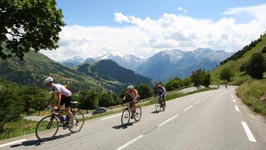
Training for road cycling
The road cycling is essentially an aerobic sport which uses strongly the cardiovascular system.
Contrary to running, it is a "carried" sport which uses less muscular groups and allows easier recoveries because of inertia. It requires then two or three times more training time.
Further more, cycling uses the leg muscles from concentric contraction which is much less traumatic for the fibers than the excentric contraction of running.
The various constraints (gravity, aerodynamics, friction) are important to know to improve the performances. They can be analysed in detail with the following calculator:
We can highlight for example, that the weight of the cyclist (and equipment) is not a big problem on flat roads, while it's a major handicap to climb. Consequently, depending on the road profile, the cyclist morphology will be more or less advantageous for the performances.

Aerobic power and endurance
To develop the power, it is recommended to train on timed rides (plain or mountain), because the effort intensity is much more important than the distance.
Indeed, the maximum oxygen flow (VO2 maximum) is fundamental to improve the maximum aerobic power (MAP).
As this power can't be maintained more than 6 to 8 min (Ref.), you have to practice this maximum duration or fractions of that period.
Interval training will consist to repeat an effort period (in maximum oxygen consumption) and a recovery period.
The splitting parameters (effort time, recovery time, number of repetitions, number of sets) are defined from the MAP with the following calculator:
Note also that the important concepts of aerobic potential (VO2max) and power/weight ratio are associated with the cyclist weight. They are consequently more useful for mountain than plain for the reasons mentioned in the beginning.
Finally, endurance improvement requires not only important distances, but also sufficient intensities.
You can use long splitting to improve the percentage of the power on the distance (%MAP).
Anerobic power and capacity
The anaerobic metabolism is not to be overlooked in some cases (competition, muscular growth, etc.) because it is necessary for accelerations and sprints.
Although it is possible to improve it on road with specific sessions, the improvement of "fast" muscular fibers is to do by body-building (squats, etc.) with heavy loads (Ref.).
Equipment
The equipment is important for the cyclist can best express his qualities.
However, it is not necessarily useful to buy a very expensive sophisticated bike because "the bike does not make the cyclist". Generally, it's sufficient to adapt the bike to the need of the cyclist and his power.
J.L